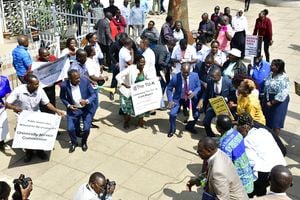
Elgeyo-Marakwet
Premium
Marakwet families wait for elusive Uhuru’s Sh1bn pay-out
In the run-up to the 2017 General Election, President Uhuru Kenyatta promised the release of Sh1 billion to compensate more than 500 families displaced from their ancestral land in Elgeyo Marakwet County to pave the way for mining.
Landowners have sought redress for the past five decades as Kenya Fluorspar Company excavated the precious minerals, making them squatters in their own land.
When President Kenyatta toured the region on June 10, 2017, he promised that the Nyaru-Iten road would be tarmacked, Sh1.1 billion for the Iten-Tambach water project and the Sh22.2 billion Kimwarer dam, among other campaign pledges to woo voters as he sought a second term for Jubilee administration.

The President assured families whose land had been taken over for fluorspar mining that they would be compensated in a few weeks’ time.
But four years later, as President Kenyatta’s two-term tenure ends, members of the Kimwarer Sugutek (Fluorspar) community are still waiting for the money.
Local leaders now want the government to honour its promises and pay land owners. The issue has been campaign fodder in every General Election.
They have written to President Kenyatta, urging him to resolve the matter before his term ends.
“Your Excellency, we recall that recently during the campaigns for your 2017 re-election you offered Sh1 billion to be released as compensation for these families,” said Dr Micah Kigen on behalf of the land owners.

Abandoned property in the area.
“Instead over half of the money we are reliably informed has been consumed and wasted on meetings by government officials charged with effecting the payments. The other half we do not know where it evaporated to. I therefore humbly request you to intervene in this matter and force an immediate and lasting solution.”
Mr Kigen wants the government to allocate alternative land for the residents to save them from the high cost of buying land elsewhere.
“The families should also be compensated for the loss of livestock, damages to property and environmental pollution and degradation,” he added.
The Kimwarer dam in Keiyo South was cancelled while the Sh28.3 billion Arror dam in Marakwet West stalled following corruption allegations that reignited hostilities between the Keiyo and Marakwet communities.
Elgeyo-Marakwet County is predominantly occupied by the Marakwet and the Keiyo, sub-tribes of the Kalenjin community. For decades, they have been at loggerheads over control of natural resources and political supremacy.
The explosive compensation matter has split displaced families, with some seeking alternative land while others want cash.
Another group has vowed to stay put in their ancestral land, arguing that they have not been affected by the mining activities, as local leaders lobby for another investor to resume mining in the region.

Keiyo South MP Daniel Rono has criticised the split and instead called for collaboration with government bodies to hasten compensation.
“Those trying to create a split are not genuine residents affected by the fluorspar mining but are out to benefit from free money. As leaders, we are awaiting response from the National Land Commission (NLC) on the way forward,” he said.
Governor Alex Tolgos has appealed for inclusive talks between residents, local leaders and the government on how to resolve the stalemate.

Joseph Cheruiyot during the interview.
“The negotiation should not be hurriedly done and all parties need to be involved in order to reach an amicable solution to this problem,” Mr Tolgos said.
“We also want local people to buy shares in the new management so that they are part of the ownership.”
Kimwarer Sugutek (Fluorspar) community chairman Joseph Kandie disclosed earlier that families had been listed in order to identify genuine beneficiaries and the mode of payment.
“There will be verification of names before a final list is forwarded to relevant departments for the release of funds,” he explained.
But some of the residents who were displaced over 50 years ago have dismissed the Sh1 billion compensation, saying it is inadequate compared with current land prices.
They want Sh3 million per acre for what they claim is 921 acres under mining.
Residents will know their fate after NLC officials establish the genuine beneficiaries, said acting CEO Kabale Tache Arero.
“The Ministry of Mining and NLC came up with a task force to handle the issue of past and present compensation. Until then, no payment will take place,” Ms Arero said in an earlier interview
A vetting process that started in 2018 to identify genuine beneficiaries does not seem to have been concluded.
The push-and-pull between the Ministry of Mining, NLC and the office of the county commissioner of Elgeyo Marakwet over records of previous payments explains why affected landowners have not been paid.
“There were people who were compensated in the 1970s by the county council. When it was raised, we were summoned by the National Assembly…we had to request information from the county commissioner, but he gave us inconclusive information, barring us from finalising this matter,” Ms Arero said.
Kenya Fluorspar Company suspended mining operations and laid off workers six years ago owing to a slump in fluorspar prices in the world market.
The company eventually wound up its activities as fluorspar prices dipped further.
The exit of the Kerio Valley-based mining company leaves South Africa and Morocco as the remaining African countries extracting the mineral.
South Africa produces 300,000 tonnes annually and Morocco 100,000, while Kenya produces an average of 120,000.
“A prolonged global slump in commodity prices has negatively impacted on the extractive business, including fluorspar. Low demand and declined prices since 2012 has led to losses,” said a former company official, who did not want to be named.
In Kenya, the fluorspar used in the manufacture of fluoride for cooling plants is mined in Keiyo South sub-county.
Mining Cabinet Secretary John Munyes has in the past admitted that many underlying issues need to be resolved before the cash is released to beneficiaries.





